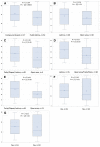Within-Compound Versus Public Latrine Access and Child Feces Disposal Practices in Low-Income Neighborhoods of Accra, Ghana
- PMID: 29557327
- PMCID: PMC5953368
- DOI: 10.4269/ajtmh.17-0654
Within-Compound Versus Public Latrine Access and Child Feces Disposal Practices in Low-Income Neighborhoods of Accra, Ghana
Abstract
In crowded urban settlements in low-income countries, many households rely on shared sanitation facilities. Shared facilities are not currently considered "improved sanitation" because of concerns about whether hygiene conditions sufficiently protect users from the feces of others. Prevention of fecal exposure at a latrine is only one aspect of sanitary safety. Ensuring consistent use of latrines for feces disposal, especially child feces, is required to reduce fecal contamination in households and communities. Household crowding and shared latrine access are correlated in these settings, rendering latrine use by neighbors sharing communal living areas as critically important for protecting one's own household. This study in Accra, Ghana, found that household access to a within-compound basic latrine was associated with higher latrine use by children of ages 5-12 years and for disposal of feces of children < 5 years, compared with households using public latrines. However, within-compound access was not associated with improved child feces disposal by other caregivers in the compound. Feces was rarely observed in household compounds but was observed more often in compounds with latrines versus compounds relying on public latrines. Escherichia coli and human adenovirus were detected frequently on household surfaces, but concentrations did not differ when compared by latrine access or usage practices. The differences in latrine use for households sharing within-compound versus public latrines in Accra suggest that disaggregated shared sanitation categories may be useful in monitoring global progress in sanitation coverage. However, compound access did not completely ensure that households were protected from feces and microbial contamination.
Figures



References
-
- Liu L, et al. 2012. Global, regional, and national causes of child mortality: an updated systematic analysis for 2010 with time trends since 2000. Lancet 379: 2151–2161. - PubMed
Publication types
MeSH terms
Grants and funding
LinkOut - more resources
Full Text Sources
Other Literature Sources

